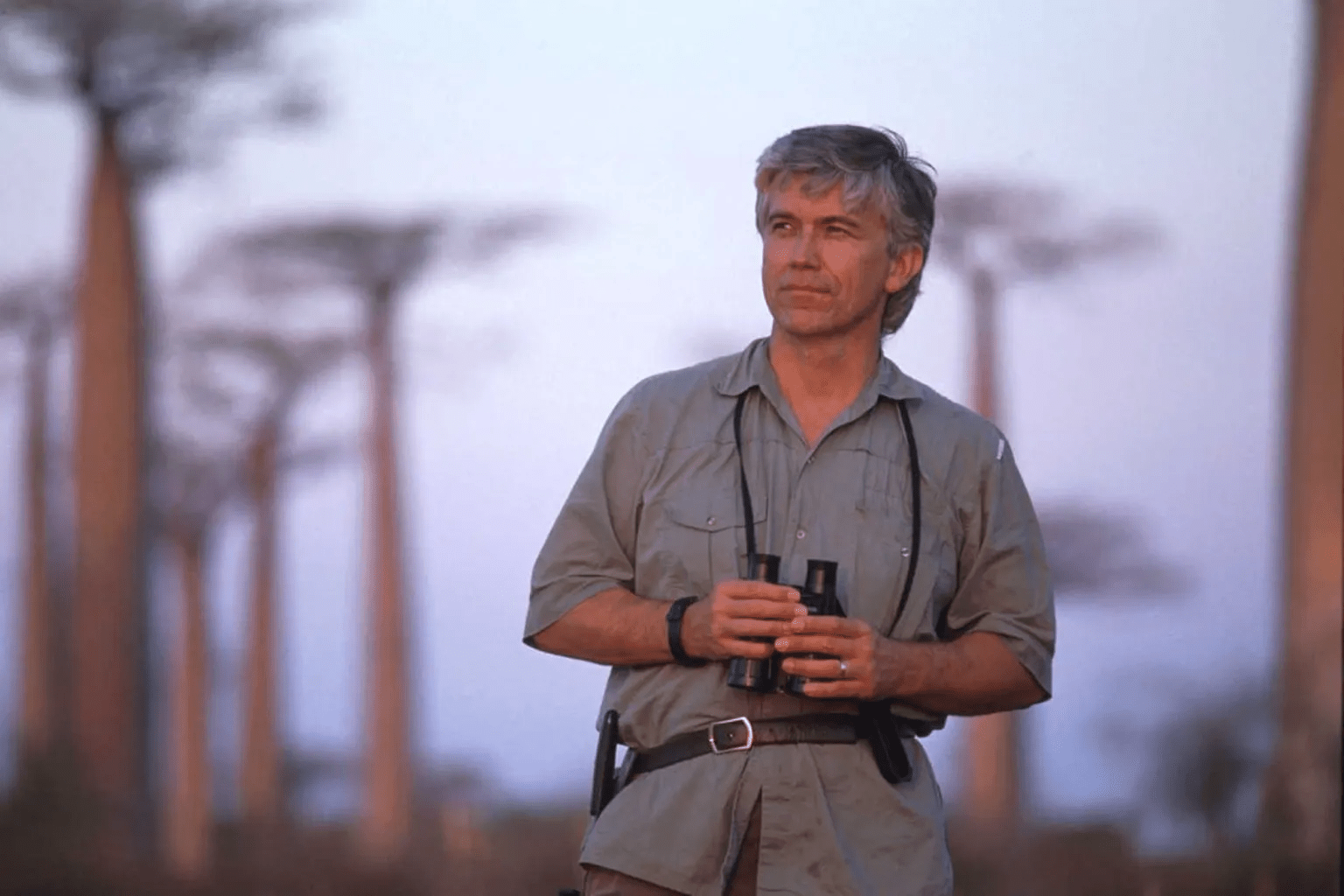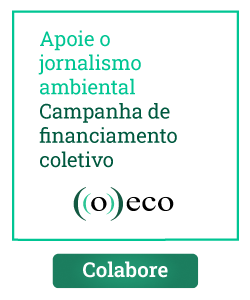Russell Mittermeier saw his first monkey in Bronx Zoo, New York. It was the ’50s, and he remembers being captivated by a bald uakari (Cacajao calvus). He didn’t know, back then, that non-human primates would become the most familiar animal sightings of his life. He has encountered more than 420 species and subspecies in the wild — over half the primates known to science. A feat for few. Russell has built a unique career for himself not only in primatology — where he is an international reference — but also in conservation. Today, at 72, he sits atop a treasure-trove of stories, adventures and a list of 169 visited countries. His favorite among them is Brazil, where he maintains a track record of 51 years of consecutive visits.
“I’ve never skipped a year, not even during the pandemic,” he proudly tells two ((o))eco reporters in a hotel lobby in Rio de Janeiro. The interview was conducted in Portuguese, one of the six languages Russell speaks fluently, aside three others he only dabbles in, according to his own account.
In the course of a two-hour conversation, Russ, as he prefers to be called, spoke with enthusiasm about his career, his expeditions throughout Brazil and the world, his research, conservation and, of course, about the heart of his passion, primates. All while his coffee, barely touched, grew cold atop the table.
In half a century of delving into primatology and herpetology (Russ also studies turtles) , he witnessed the establishment and growth of the field into a science, and helped to consolidate primate research groups in Brazil and beyond.
“Brazil is the country with the most professionals dedicated to the field. It’s a very unique place,” he says, optimistic. “You see 200, 300 people in a primatology congress here. It became as important as the international congress, maybe even more.”

From Tarzan to academic research
Russell’s fascination with the natural world started in the Zoos of New York city, his home town, while he was still a child, and was further inspired by a character: Tarzan. In the hero’s stories, Russ found a portal to African forests filled with animals. In particular, monkeys, which raised Tarzan and helped transform him into a defender of the jungle. An irresistible analogy to how primates would help Russell himself become a nature protector.
But before he was enthralled by monkeys, the son of German immigrants dedicated his time to the capture of small reptiles in the ’50s and ’60s Long Island, when there were still woodland areas to explore. The felling of these trees for the construction of houses in an expanding New York awoke a sense of revolt in the mind of the blooming environmentalist.
Once older and set on his desire to study primates, Russ thought that Africa should be his destination. He wrote letters to leading experts of the time, such as Louis Leakey, Jane Goodall’s mentor, but was refused. This was, however, a serendipitous setback, one that led him to a place mostly uncharted by primatology: Latin America.
That’s how he met researchers from The Smithsonian Institute in Panama, and was invited to study howler monkeys, an enterprise that led to his first fieldwork in Barro Colorado Island, in the ’70s.
From there, Russell carried out a survey of all studies on neotropical primates published at the time. “There was very little information,” he recalls. Still, his analysis resulted in a never-published 300 page document, concluded before his graduation. “Things which we know nothing about are the ones I like to study the most,” he says with a wide smile. “They’re the most fun.”

In 1971, after his graduation from Dartmouth College, he decided to explore new research possibilities in the American continent, visiting Panama, Colombia, Uruguay, Paraguay, Argentina, Chile, Bolivia, Peru, Ecuador and, for the first time, Brazil, arriving in a flight Russ remembers to this day.
“I went from Letícia [in Colombia] to Manaus. It was the worst flight of my life. The door of the plane opened mid-flight, [there was] a lot of rain, everyone was vomiting… that was my introduction to Brazil. And I came back,” he remembers, laughing.
His Brazilian saga continued on land. From Manaus he headed towards Belém, and from there he took a bus to Brasília and a second one to Rio de Janeiro, where he met Adelmar Coimbra-Filho, an already world-renowned primatologist that “welcomed him like a son,” he recalls. It was also back then that he met Maria Tereza Jorge Pádua, Alceo Magnanini and Paulo Nogueira Neto, three iconic Brazilian conservationists who worked for the Parks division of the Brazilian government at the time.
Back in the United States, Mittermeier enrolled in Harvard’s Biological Anthropology master’s program, where he would later also pursue his PhD.
The search for the “Amazon Yeti”
Russell decided to return to Brazil — to the Amazon — in 1973. He enlisted the support of Paulo Vanzolini, a Zoologist from Universidade de São Paulo (University of São Paulo, USP) who kept two boats called Expedição Permanente da Amazônia (Permanent Amazon Expedition), to launch a four-month expedition of his own.
This adventure was intended to follow the steps of 19th century naturalists Henry Walter Bates and Alfred Russel Wallace, and to find the bald uakari (Cacajao calvus), the same monkey Russ had seen in the zoo as a child.

“Wallace and Bates published two fantastic books [about their expeditions in the Amazon]. I read them, and both mentioned the uakari, the red-faced monkeys. When I was a child in the Bronx I saw a bald uakari, the single one they had in captivity. That was in the ’50s, when they started to talk about yetis in the Himalayas. For me, the bald uakari was a mini-yeti, and I told myself ‘I have to see this animal’. I put this expedition together mostly to see uakaris.”
Little was known about the bald uakari back then, a species that inhabits a small region of the Amazon. Standing between 50 and 60 cm tall, they have quite a striking look: a white furred body with a naked red head. An image that is worthy of a mythological creature, like a yeti.
Until 1973, only Brazilians had registered wild encounters with these animals. Bates and Wallace received the monkeys from locals, “but they never spotted one in nature,” explains Russ, bragging about being the first “foreigner” to see them in the forest, an encounter he notes as one of the most memorable experiences he ever had with primates. “It was fantastic.”
“I visited Rio Negro and its tributaries, and I found the black-headed uakari (Cacajao melanocephalus). They are one of the most common monkeys in the area. From there I went to the Panauã river region, now in Mamirauá [Sustainable Development Reserve], where I saw the bald uakari. Then I went to Ica river and saw the red bald-headed uakari (Cacajao rubicundus). I saw all three species of uakari known at the time during this expedition,” he says.

There are currently eight recognized uakari species, all endemic to the Amazon. The most recent was described in June of this year in the Amazonas State, and was named uakari-dos-Kanamaris (Cacajao amuna).
“That was the best expedition I ever participated in, and it was over fifty years ago,” he says. The conditions to study these primates back then were too difficult though, and he felt discouraged from designing his doctoral project around uakaris.
“Luckily, I met a Dutch botanist who’d been to Surinam, and he told me he’d seen the cuxiú [Chiropotes sagulatus] there, a close relative to the uakari with a long tail and a strange head. Then I thought to myself, ‘I’m going there to study these animals,'” says the primatologist, who concluded his PhD in 1977 with the thesis “Distribution, Synecology and Conservation of Surinam Monkeys”.
The guardian of primates
Mittermeier has been the chair of the International Union for Conservation of Nature (IUCN) Primate Specialist Group since 1977. “I started when I was 27. We were 20 people at first, but the group now has about 800 members. I broke the world record for time spent as chair of a specialist group,” he laughs while admitting his own shock when he thinks about his tenure that way.
The group promotes taxonomic knowledge to aid in the correct identification of species, “because you can’t do conservation when you don’t know who your animals are and where they live.” The group is also responsible for the development of the IUCN Red List of threatened primates.
“Each decade, we evaluate which species are threatened, critically threatened or vulnerable. It’s a complicated process. It started out last decade, in 2012, and now we’re finally concluding the evaluation of 719 different primates,” he says, relieved.
Science currently recognizes 81 genera of primates, including 529 species and 719 different taxa among species and subspecies. “But that is always changing, because we’re always discovering new species.”
According to Russ, nearly 100 species have been discovered since the year 2000, most of them in Madagascar, the African island that is home to lemurs and to the second greatest biodiversity of primates of the world, behind only Brazil.
Russ first visited the African country in 1984, brought by the World Wildlife Fund (WWF) to follow several conservation projects funded by the organization. He took the opportunity to see lemurs. “I liked Madagascar a lot, but I still prefer Brazil. Brazil is number one country for primates, Madagascar is number two, Indonesia three and Congo number four,” ranks Russell. When put together, these countries house around 60% of all primate species. Brazil alone is home for 151 taxa (species and subspecies).

And among them is a homage to Mittermeier himself, an Amazon monkey named Pithecia mittermeieri, described in 2014. But this is not the first species to honor Russ. The primatologist’s last name has also been given to a family of three frog species, a lizard, two lemurs and even an ant.
In the other side of the biodiversity scale, where the species that disappeared from nature lie, Russ points out that no primate was lost in the 21st century, although several species are now on the edge of extinction.
He names the red colobus (Piliocolobus waldronae), an African monkey that occurs in the frontier between Ghana and Côte d’Ivoire, as an example. A Re:wild team is currently surveying the last place the species was sighted, over 50 years ago, using camera traps and drones, in an attempt to determine if the monkey still exists.
The last primate extinction recognized by science dates back to 500 years ago, when the last of the giant lemurs that inhabited Madagascar supposedly disappeared. Other species in this fantastic group of lemurs — one of them the size of a gorilla! — disappeared around 2 thousand years ago, when a different primate, human beings, first arrived at the African island.
Madagascar is currently a focal point for primate conservation. According to Russell, around 90% of the island’s species are under some level of threat. “Even with all our efforts it’s a frustrating situation. There are species with 50, 60, 80 individuals left,” he warns.
Golden lion tamarins and the partnership with Coimbra-Filho
One of the Brazilian primates that left a mark on Russell’s career was the golden lion tamarin (Leontopithecus rosalia), a species that occurs solely in Rio de Janeiro State’s Atlantic Forest. This mark was due both to the animal itself and to the friendship Russ developed with Adelmar Coimbra-Filho, the main voice in defense of the threatened tamarin.
His first encounter with the animal happened in 1979, when Russell took what he believes to be the first photograph of the tamarin in nature. Less than 200 individuals were estimated to exist in the wild at the time — an assessment that was published by Mittermeier and Coimbra-Filho themselves.

“Coimbra was the first real Brazilian primatologist,” says Russ, proud of his friend that passed away in 2016.
In 1972, both researchers, together with the agronomist Alceo Magnanini, were summoned to a conference titled “Saving the Golden Lion Marmoset”, organized by the Wild Animal Propagation Trust at the Washington’s DC National Zoo, in the United States. The conference gathered specialists from all over the globe to, for the first time, discuss and plan an international strategy to save the golden lion tamarin from extinction.
“They called this meeting and invited me together with Coimbra and Magnanini because I was one of the few primatologists that had been to Brazil and could speak Portuguese. I went as a translator as well. In that meeting, Devra Kleiman took upon herself the responsibility to determine why these animals didn’t breed well in captivity. She spent a decade studying the animals, and learned what was necessary to allow the captive population to grow,” says Russ.

The successful management of captive — or ex situ— populations was fundamental to save the species from extinction, allowing zoo-kept tamarins to be reintroduced and once again fill their natural habitat.
“This was the start of a movement that produced these international management committees. This international collaboration between zoos and experts is, in my view, a great model for the conservation of any threatened species today. They also created committees for two other tamarins, and it worked,” he concludes.
This success can be proven in numbers. From the brink of extinction, the wild population of golden lion tamarins bounced back to an estimate of 2,500 individuals. The species is still classified as Threatened by the IUCN, but is definitely in a more comfortable situation now than when Russ first met them.
“That shows the importance of doing a lot of research, putting in a lot of effort and persistence. There has to be dedication, the right people working on the matter. These are the kinds of things that make conservation work,” he says.
Brazilian roots and seeds
This relationship with the tamarins and with Coimbra made Russell decide to carry out a survey of Atlantic forest primates. “I met with Thomas Lovejoy [a renowned conservationist] in 1975. He read the report of my 1973 expedition and, as someone deeply interested in the Amazon, contacted me and asked: ‘Why don’t you perform a primate survey in the Amazon?’ And I responded: ‘Good idea, but I think the Atlantic forest has priority,” he remembers.
While working at the WWF, between 1978 and 1989, Russ raised funds to perform this survey in all protected areas across the Atlantic forest.

“It started in 1979. The first place we visited was Poço das Antas [Biological Reserve], where I had seen the tamarins. Then we headed to Fazenda Montes Claros [Montes Claros Farm, currently known as Feliciano Miguel Abdala Private Natural Heritage Reserve] to see the muriqui with professor Célio Valle, from Universidade Federal de Minas Gerais (UFMG). Coimbra, Célio Valle and Admiral Ibsen were the Brazilian partners of this expedition, which lasted almost ten years. We trained a lot of people then, especially in UFMG,” says Russell.
This mapping emphasized the three species of lion tamarins known at the time: the golden lion tamarin, the black lion tamarin (Leontopithecus chrysopygus) from São Paulo State and the golden-headed lion tamarin (Leontopithecus chrysomelas) from Bahia.
“The great mistake we made during this survey was to focus our efforts only in Bahia, Espírito Santo, Minas Gerais and São Paulo, because we believed nothing interesting would be found in the State of Paraná.”
And then, in 1990, two very young girls [Vanessa Persson and Maria Lúcia Lorini] found a fourth tamarin, the black-faced lion tamarin (Leontopithecus caissara) there. We should have gone to Paraná as well,” he says, laughing.
“And in 1982, I brought Karen Strier,” Russ continues, talking about the arrival of the American primatologist who would study the northern muriqui (Brachyteles hypoxanthus) at Feliciano Miguel Abdala’s reserve, in Caratinga, Minas Gerais. A work that now spans four decades. “She has done an amazing job during these 40 years. She trained over 100 Brazilian experts. Very few people manage to conduct a study for this long,” he says.
The seeds Karen, Russell and other researchers planted in Brazilian science yielded many fruits. According to Mittermeier, Brazil currently has more primatologists than any other tropical country. “I think it even has more primatologists than the United States right now,” he remarks.
The researcher also emphasizes that the Brazilian experience isn’t restricted to national boundaries. “This know-how is slowly being transferred to other countries as well, especially due to the effort of Leandro Jerusalinsky [from the Centro Brasileiro de Primatologia, or Brazilian Primatology Center – CPB/ICMBio], the current president of the Sociedade Latinoamericana de Primatologia (Latin American Society of Primatology, SLAPrim). He is helping a lot in Bolivia and Paraguay. Colombia has its own [primatology] society now, as does Ecuador and Peru,” he says.
A spokesperson for philanthropy
Russell Mittermeier is the current Chief Conservation Officer of Re:wild, an international group that replaced the Global Wildlife Organization and works for the protection of Earth’s biodiversity. An important part of the primatologist’s job is raising funds and attracting donors to support the cause.
This function includes traveling with potential donors to meet new conservation projects and natural areas in order to inspire them to take part in environmental philanthropy. That’s the reason that brought him to Brazil in April of this year, when this interview was conducted. His trip had three destinations: the Pantanal; Feliciano Miguel Abdalla reserve and the northern muriqui conservation project; and Rio de Janeiro’s countryside, where he visited the Golden Lion Tamarin Association (Associação Mico-Leão-Dourado, AMLD).
“I do much of my fundraising while traveling. When it comes to important donors, I don’t just visit them in their offices, I take them on trips. A week, two… for them to better know who we are and what we do, because fundraising is mostly about forging relationships with people. I make a point of visiting Madagascar, the Atlantic forest, the Pantanal, Surinam or wherever two or three times every year, bringing big potential donors with me,” says the primatologist, defining a “big potential donor” as someone capable of making donations reaching seven figures.
This list includes Hollywood names like Harrison Ford and Leonardo DiCaprio, who is currently a board member of Re:wild.
“Many developing countries need resources from richer nations because they still lack the capacity or political will to dedicate substantial resources of their own to conservation. And the United States has this private philanthropic tradition, which is the best money there is in my opinion, because bureaucracy consumes much of the money that is passed between governments. And governments usually don’t like NGOs all that much. This is world wide. As it so happens, biodiversity and conservation depend on the groundwork of NGOs more than any other sector,” he says.

Russ admits that reconciling his work as defender of Earth’s biodiversity and its thousand trips – he visited 169 countries! — with a family life isn’t easy. Married twice, Russell has three children, and two of them are involved in the environmental area. His oldest son works with bird conservation in the United States, the second is a botanist, and his youngest daughter studies anthropology. “Fortunately, I always had the opportunity to bring one of my children along with me on my travels, so they were really exposed to conservation and to natural places. Even though I wasn’t always present, I worked hard to show them the world since they were little,” he says.
An overview of global conservation
Russell Mittermeier is an optimistic realist. He believes that improvement is always possible, but chooses to invest his energy where he sees concrete conditions to develop a conservation project. “You’ve got to be strategic,” he summarizes.
Part of this strategy is connected to the concept of biodiversity “hotspots”, an idea created by the environmentalist Norman Myers in 1988 that Mittermeier supported and helped expand during his tenure as president of Conservation International (CI), from 1989 until 2017. There are 36 recognized biodiversity hotspots in the world today.
“Originally, these hotspots occupied 16% of Earth’s surface. They’ve collectively lost around 90% of their area, which means that these natural areas now cover only 2% of the globe. And at least 50% of the plants and over 40% of the vertebrates are endemic to these areas. So, if you lose these hotspots, you automatically lose half of all plants and animals. Strategically speaking, we need to focus a lot of effort on these places. Here in Brazil we have the Atlantic Forest and the Cerrado. Latin America also has the tropical Andes, Mesoamerica… all of these are hotspots,” he explains.
At the same time, it is important to give attention to intact areas where biodiversity is high (megadiverse places) and wildlands. This list includes the Amazon, the Congo and Papua New Guinea. “If you do good work in these regions, you have hope,” he adds.
With a hopeful tone, Russell talks about the recent history of Atlantic Forest conservation as a success case. Despite the destruction of over 80% of the biome following Brazil’s colonization, he has witnessed, since his arrival in the country in 1971, the hard work of many specialists and the creation of several protected areas, including private ones; and, more recently, restoration initiatives, including the reintroduction of locally extinct animals.
“But nothing is more important than protecting the natural areas that still exist. Without them there is no rewilding. Rewilding is a good thing, but it depends on nature that still exists in protected natural areas. If you want to rewild, but there’s no source for you to work with, what then? Planting eucalypti?”
“We have to incentivize farmers to let forests grow, and to guard protected areas well. We also need scientific presence, and not only for research. It works almost as park rangers. And we need communities to get more involved. Ecotourism is also very important, in my opinion,” says Russell.
The primatologist believes that Brazil is doing well in comparison with other countries, mostly due to people’s growing commitment with the environmental agenda. “The increasing interest in conservation over the last 50 years in Brazil is truly impressive. When I first arrived here there were very few people working in conservation, few national parks and biological reserves. Little by little people grew aware of these issues here, and in a very powerful way,” he ponders.
“If you didn’t see what we started out with, it is easy to become pessimistic. But if you saw how little there was in the beginning, and compare it with everything we have now…” he says, provoking the two pessimistic journalists before him.
Primate watching
One of Mittermeier bets for the future is “primate watching”, a concept he developed 20 years ago, inspired by birdwatching tourism — a worldwide billion dollar industry.
“My oldest son is a top notch birdwatcher. He’s traveled across 125 countries, and through him I see how well connected the birdwatching community is, and how impactful they are. There aren’t nearly as many primates as there are birds in the world — there are 11 thousand birds and only 719 primates — but monkeys, lemurs and apes are popular, and they are tropical forest icons. So I thought, ‘why don’t we do something similar with primates?’ And we are slowly doing just that.”
Mittermeier himself is, without question, the greatest “primate watcher” in the world today. He has seen over 420 different primates across the globe. “It only counts when I see them in nature. Telemetry can help, but it has to be in nature,” he explains.
In spite of being the person who has seen the most primates, Russ recognizes that completing the list of sighted species is impossible. “Ten years ago I said that I had to see at least every genus, which were 80. And at the beginning of 2019 I saw the last remaining one. It happened in Tanzania, with a BBC crew filming the whole thing,” says Russell, recounting his trip to see Rungwecebus kipunji, a monkey from the Rungwecebus genus. The eightieth and final genus. Or at least, it was. In march of this year, a taxonomic review regarding the pygmy slow loris (Xanthonycticebus pygmaeus) allocated it into a new genus, and now there is an 81º genus, one yet unseen by Mittermeier.
“Now I have to see this one,” he says with the enthusiasm of someone about to complete a sticker album. And when asked about which other species he would like to see one day, he responds that “basically, I want to see everything I haven’t seen yet.”

* This story was originally published in Portuguese in ((o))eco.
Leia também

In Rio de Janeiro, a forest slowly returns to life, one species at a time
Rio de Janeiro’s Tijuca National Park has become a laboratory for the reintroduction of locally extinct species. A study shows that, of the 33 species of large and medium-sized mammals that used to occur in the Tijuca National Park area, only 11 remain today. →

Trawling bycatch increases risk of marine life extinction in Brazil
Less than 10% of the 25,618 fishing boats registered by the Brazilian government are monitored by satellites, and the program that tracks fishing boats by these satellites is not publicly open and not integrated with worldwide monitoring initiatives. →

How Brazil is working to save the rare lion tamarins of the Atlantic Forest
Golden lion tamarin conservation efforts have been successful, growing the population from a one-time low of 200 animals to more than 2,000 today. →








